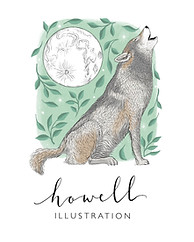What is Giclée Printing?
- Nicola Howell Hawley
- Nov 17, 2023
- 2 min read
Updated: Nov 20, 2023
Here at Howell Illustration, all of my art prints are giclée prints. But, I hear many of you ask, what is a giclée print? And why should it matter to you? Well, I'm here to help you out.

Back when I started Howell Illustration, I used to print everything at home. Everything was printed on my very fancy Epson printer. And it took forever. I'd be up until 1/2 in the morning after a market sometimes, trying to refill my prints, posters and cards for a market the next day. I'd make stupid mistakes, get the printing wrong, the printer would crash, my software would inexplicably reset itself. The list went on, it was endless. The problem was, I had no real idea how to send it to a printer, what printer to send it to, what paper I wanted to use - anything! (And if you want a blog on that, let me know!)
So began, a very steep learning curve. This learning curve led me to eventually to my current printer, D Studio, and to giclee prints and my first thought was . . .
How on earth do you pronounce that?
I discovered, thanks to a helpful blog, that it's pronounced 'zhee-KLAY'. Still confused? You're not alone. Feel free to check out this YouTube link for a quick lesson.
What is giclée printing?
Put simply, 'giclée' is inkjet printing, and the term refers to the way the ink is 'sprayed' onto the page. An art print is a digital copy of an original art piece. Therefore, a giclée print is a digital replica of the original piece, produced using advanced inkjet technology. Sounds straightforward, doesn't it?

Why does it matter? And why is it so much more expensive?
The importance lies in the fact that a giclée art print offers the highest quality available on the market, with a significantly longer lifespan compared to your standard inkjet print. I have bought other talented artist's work before only to find that within a year, the print has faded or the colours have changed. While supporting independent artists is important, I also want to ensure that what I sell withstands the test of time. So, I choose to have all of my art prints professionally giclée printed on archival paper (paper that doesn't rot as quickly as other paper). This in turn makes my outlay more expensive, and this means my prices are a bit higher. But, like they say, you get what you pay for, and in this case, you do.
(I also use eco-friendly hemp paper for my prints, and I have them wrapped in biodegradable 'plastic' - actually made from corn starch. Also, my printer ships everything out in paper packaging, so win win all round.)
I hope that helps if you weren't sure what it was! Please feel free to leave any comments or ask any questions on the process, and let me know if I can help!
As always, thanks for reading,
Nx

Comentários